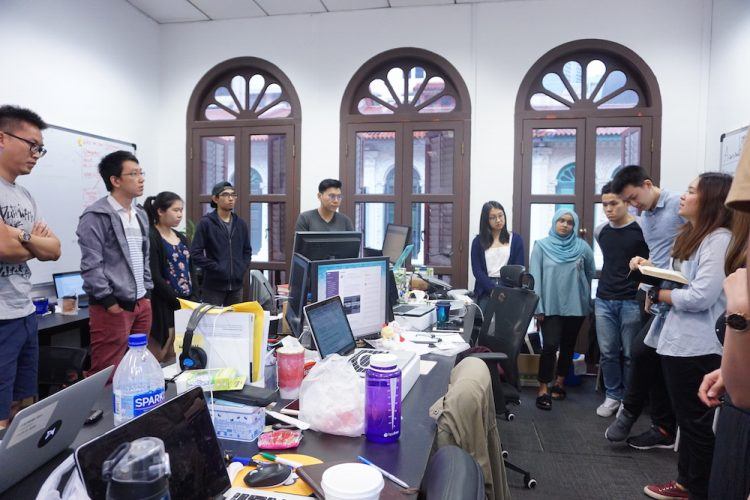The Inside series is a column where the Tech in Asia Jobs team gives an insider’s glimpse into interesting companies and professions. Looking for a job? Search thousands of jobs for free on Tech in Asia Jobs.
The mid-morning chatter trailed off as Airfrov CEO and co-founder Cai Li walked into the room and reached for a bell perched on a cabinet.
The bell rings.
The 10-odd members of the product and marketing teams rise to their feet for their daily standup meeting. I rise with them.

A user joins in the daily standup meetings as far as possible. / Photo credit: Sim Yanting
An Airfrov user joins the team’s daily standup meeting whenever schedules align. I was the user in the hot seat that day. After a brief round of introductions, Cai turns to me and asks, “So, what do you not like about Airfrov, and how can it be improved?”
The story of Airfrov

The name Airfrov represents the sharing economy enabled by frequent air travelers. It also plays on Cai’s inexplicable love for the Afro hairstyle. / Photo credit: Sim Yanting
Airfrov is a C2C marketplace that connects travelers with buyers seeking goods from their destinations.
Founded in 2015 by Cai and Robi Ng, the concept was born from an opportunity that Cai spotted while working in a job that required frequent traveling. Every time he traveled, his friends and girlfriend would request for items exclusive to these countries. Through Airfrov, travelers can now get a small monetary incentive for purchasing items requested by buyers. In exchange, buyers get to enjoy imported products without having to pay hefty shipping fees.
The platform is now operational in Singapore and Indonesia, and processes over 800 requests daily.
Keeping users at the forefront of decision-making
Cai credits Amazon CEO Jeff Bezos’ concept of “the empty chair” for Airfrov’s daily user sit-in sessions. Bezos is known to leave an empty seat at meetings to represent the Amazon customer, “the most important person in the room.”
Cai, however, tweaked that idea for Airfrov. “Instead of keeping the seat empty, I thought, why not invite a real customer?” he says.
Users are constantly dropping by the Airfrov office to deposit or collect items, allowing Cai to involve them in the research and development process.
Identifying user problems first-hand
By getting feedback directly from users, the product and marketing teams can gain insights and spot pain points that are easily overlooked by the UX team.
“Instead of looking into completing specific tasks, we get to see how people use Airfrov on a daily basis,” shares Cai.
One of the first things that Cai and the team noticed was the duplication of requests from other buyers.

Image credit: Airfrov
“We noticed users coming in to say that they wished that they could copy and paste what others were requesting, so they don’t have to go through the whole process of creating a new request,” explains Cai. “As such, we came up with the ‘I want this too!’ button, which has become a core feature of our product today.”
Motivation for the team
According to Cai, bringing in users gives the team strong motivation. “It lets them know that whatever they’re doing is going to impact the life of this user,” he adds.
Taking this approach, however, also means that users can see the nitty-gritty of the product development process. Doesn’t this kind of exposure bother Cai?
“Not really,” he laughs. “We want to involve the users as much as possible in this process. We want them to see how difficult decisions are made. And we would rather that they give us feedback early on.”
The next steps
The information gathered from this process either ends with a new feature in Airfrov’s future iteration, or in the idea graveyard. Here’s how the process looks like.

Image credit: Joshua Lim
Improvements to the product development process
Going forward, Cai wants Airfrov’s engineers to be more involved in the user experience side of the business. As he points out, “Part of our onboarding process requires everyone at Airfrov, including engineers, to be in customer service and learn to serve our customers. But after the onboarding process, they are no longer the ones speaking to users.”
Cai tries to get engineers to speak to users at least once a month, but their involvement is limited because of Airfrov’s resources.
“We have to set aside time for them to do that, but right now, we can’t afford to,” he says. “I wish that they would be able to speak more to our users and see the customer’s problems for themselves. This will give them a better idea of the big picture, and the role they’re playing to solve these problems.”
Can Airfrov retain its close relationship with users when the company scales, and one-to-one interactions become less feasible?
“Why not?” asks Cai. “All it takes is for us to continue to show care and concern, and seek honest feedback. If users truly enjoy the product, they will be more than happy to join us on this journey.”
This post How Airfrov keeps its eyes on the customer appeared first on Tech in Asia.
from Tech in Asia https://www.techinasia.com/airfrov-eyes-customer
via IFTTT
No comments:
Post a Comment